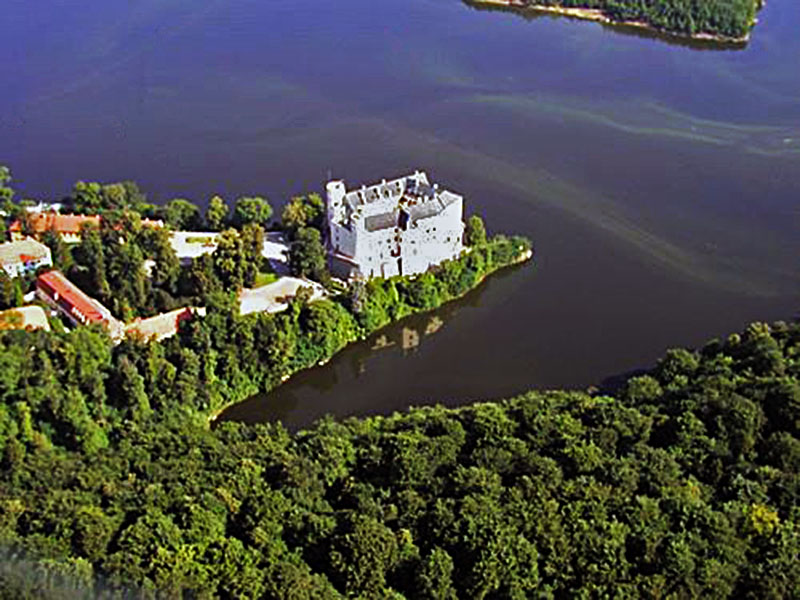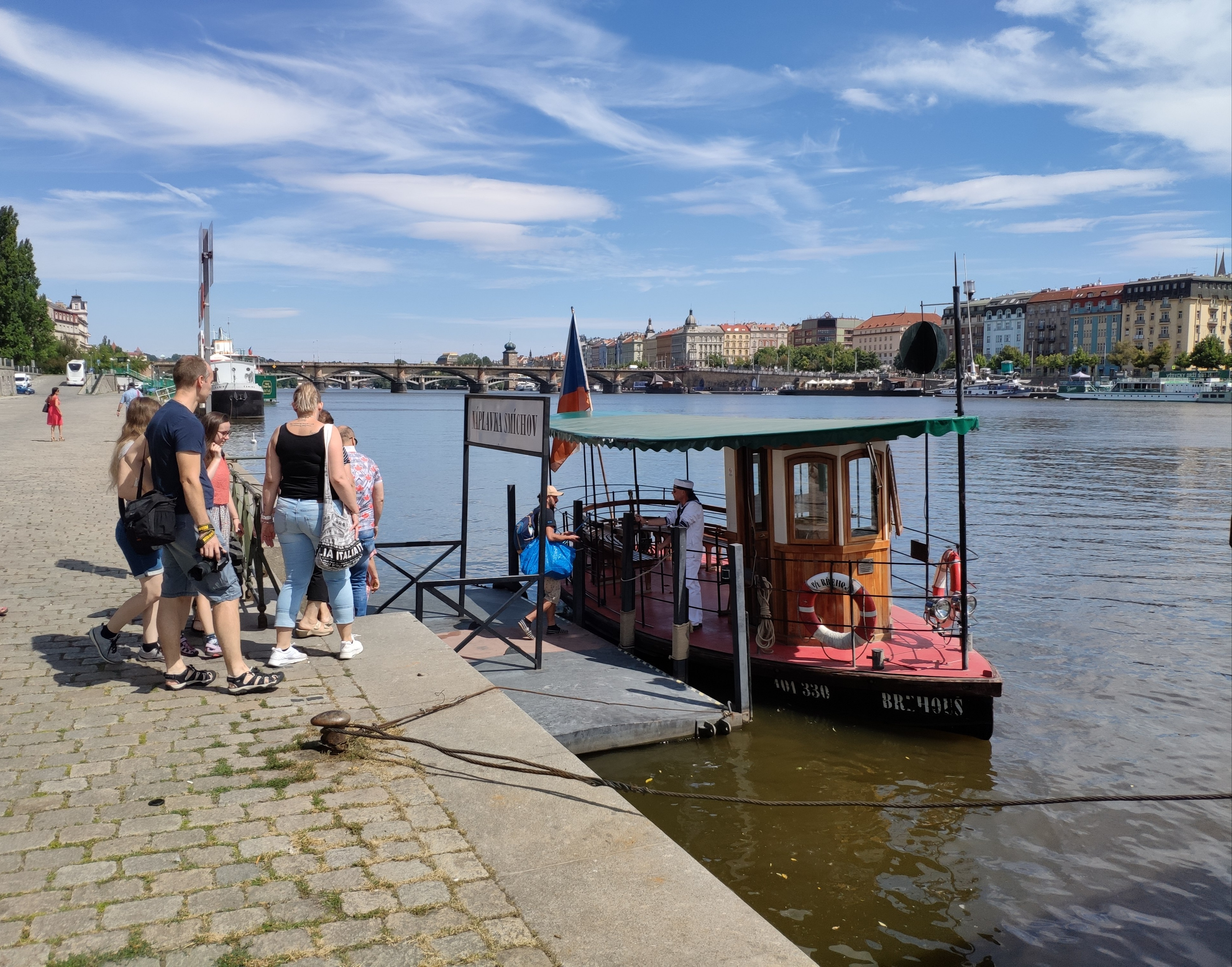|
Milešov
Milešov is a municipality and village in Příbram District in the Central Bohemian Region of the Czech Republic. It has about 300 inhabitants. Administrative division Milešov consists of three municipal parts (in brackets population according to the 2021 census): *Milešov (209) *Klenovice (91) *Přední Chlum (22) Geography Milešov is located about southeast of Příbram and south of Prague. It lies in the Benešov Uplands. The highest point is the hill Bukovec at above sea level. The western and northern municipal border is formed by the Vltava River, respectively by the Orlík and Kamýk reservoirs, built on the Vltava. History The first written mention of Milešov is from 1323. The village was founded in the 14th century as a result of gold and antimony mining in the area. Demographics Transport There are no railways or major roads passing through the municipality. Sights The main historical landmark of Milešov is the Church of the Assumption of the Virgin Mary. ... [...More Info...] [...Related Items...] OR: [Wikipedia] [Google] [Baidu] |
Emmy Destinn
Emmy Destinn ( (); 26 February 1878 – 28 January 1930) was a Czech operatic dramatic soprano. She had a career both in Europe and at the New York Metropolitan Opera. She was one of the greatest opera singers of the 19th and 20th centuries. Biography Destinn was born Emilie Pavlína Věnceslava Kittlová in Prague, in what was then Austria-Hungary. Her family soon left Prague and until the age of 14, Emmy grew up in Milešov, where her father owned mines. In 1892, she was sent to a German boarding school in Prague to learn German, playing the piano and the violin, but Anna Adamcová, a member of the National Theatre, advised her to improve her singing. Her voice teacher since age thirteen had been Marie von Dreger Loewe-Destinn, and the young singer began using her teacher's surname as a tribute. She was let go after the short engagement at the Dresden Opera and declined by Prague National Theatre in 1897. She debuted on 19 July 1898 at the Berlin Court Opera as Santuz ... [...More Info...] [...Related Items...] OR: [Wikipedia] [Google] [Baidu] |
Příbram District
Příbram District () is a Okres, district in the Central Bohemian Region of the Czech Republic. Its capital is the town of Příbram. Administrative division Příbram District is divided into three Districts of the Czech Republic#Municipalities with extended competence, administrative districts of municipalities with extended competence: Dobříš and Sedlčany. List of municipalities Towns are marked in bold and market towns in ''italics'': Bezděkov pod Třemšínem - Bohostice - Bohutín (Příbram District), Bohutín - Borotice (Příbram District), Borotice - Bratkovice - Březnice (Příbram District), Březnice - Buková u Příbramě - Bukovany (Příbram District), Bukovany - Čenkov - Cetyně - Chotilsko - Chrást (Příbram District), Chrást - Chraštice - Čím - Daleké Dušníky - Dlouhá Lhota (Příbram District), Dlouhá Lhota - Dobříš - Dolní Hbity - Drahenice - Drahlín - Drásov (Příbram District), Drásov - Drevníky - Drhovy - Dubenec (Příbram Dis ... [...More Info...] [...Related Items...] OR: [Wikipedia] [Google] [Baidu] |
Prague
Prague ( ; ) is the capital and List of cities and towns in the Czech Republic, largest city of the Czech Republic and the historical capital of Bohemia. Prague, located on the Vltava River, has a population of about 1.4 million, while its Prague metropolitan area, metropolitan area is home to approximately 2.3 million people. Prague is a historical city with Romanesque architecture, Romanesque, Czech Gothic architecture, Gothic, Czech Renaissance architecture, Renaissance and Czech Baroque architecture, Baroque architecture. It was the capital of the Kingdom of Bohemia and residence of several Holy Roman Emperors, most notably Charles IV, Holy Roman Emperor, Charles IV (r. 1346–1378) and Rudolf II, Holy Roman Emperor, Rudolf II (r. 1575–1611). It was an important city to the Habsburg monarchy and Austria-Hungary. The city played major roles in the Bohemian Reformation, Bohemian and the Protestant Reformations, the Thirty Years' War and in 20th-century history a ... [...More Info...] [...Related Items...] OR: [Wikipedia] [Google] [Baidu] |
Antimony
Antimony is a chemical element; it has chemical symbol, symbol Sb () and atomic number 51. A lustrous grey metal or metalloid, it is found in nature mainly as the sulfide mineral stibnite (). Antimony compounds have been known since ancient times and were powdered for use as medicine and cosmetics, often known by the Arabic name Kohl (cosmetics), kohl. The earliest known description of this metalloid in the West was written in 1540 by Vannoccio Biringuccio. China is the largest producer of antimony and its compounds, with most production coming from the Xikuangshan Mine in Hunan. The industrial methods for refining antimony from stibnite are Roasting (metallurgy), roasting followed by carbothermic reaction, reduction with carbon, or direct reduction of stibnite with iron. The most common applications for metallic antimony are in alloys with lead and tin, which have improved properties for solders, Bullet, bullets, and plain bearings. It improves the rigidity of lead-alloy pla ... [...More Info...] [...Related Items...] OR: [Wikipedia] [Google] [Baidu] |
Kamýk Reservoir
Kamýk may refer to places in the Czech Republic: *Kamýk (Litoměřice District), a municipality and village in the Ústí nad Labem Region *Kamýk (Prague), a cadastrial area of Prague *Kamýk nad Vltavou Kamýk nad Vltavou is a municipality and village in Příbram District in the Central Bohemian Region of the Czech Republic. It has about 1,000 inhabitants. It lies on the Vltava River. Administrative division Kamýk nad Vltavou consists of two mu ..., a municipality and village in the Central Bohemian Region See also * Kamyk (other), several places in Poland {{DEFAULTSORT:Kamyk ... [...More Info...] [...Related Items...] OR: [Wikipedia] [Google] [Baidu] |
Orlík Reservoir
The Orlík Reservoir () is the largest hydroelectric dam in the Czech Republic. It dams the Vltava River near the village of Solenice, which is near the town of Příbram. The structure is named after Orlík Castle, which is situated a few kilometers above the dam. The dam has four turbines with a nominal capacity of 91 Megawatt, MW each having a total capacity of 364 MW. Sources See also *List of dams and reservoirs in the Czech Republic *List of lakes in the Czech Republic * Dams in the Czech Republic Hydroelectric power stations in the Czech Republic Písek District Příbram District Buildings and structures in the Central Bohemian Region Dams completed in 1961 Reservoirs in the Czech Republic 1961 establishments in Czechoslovakia 20th-century architecture in the Czech Republic {{CzechRepublic-struct-stub ... [...More Info...] [...Related Items...] OR: [Wikipedia] [Google] [Baidu] |
Vltava
The Vltava ( , ; ) is the longest river in the Czech Republic, a left tributary of the Elbe River. It runs southeast along the Bohemian Forest and then north across Bohemia, through Český Krumlov, České Budějovice, and Prague. It is commonly referred to as the "Czech national river". Etymology Both the Czech name ' and the German name ' are believed to originate from the old Germanic words ' 'wild water' (compare Latin '). In the ' (872 AD) it is called '; from 1113 AD it is attested as '. In the ' (1125 AD) it is attested for the first time in its Bohemian form, '. Course The Vltava originates by a confluence of two rivers, the Teplá Vltava, which is longer, and the Studená Vltava, originating in Bavaria. From a water management point of view, the Vltava and Teplá Vltava are one river with single numbering of river kilometres. The Teplá Vltava originates in the territory of Kvilda in the Bohemian Forest at an elevation of , on the slope of the Čern� ... [...More Info...] [...Related Items...] OR: [Wikipedia] [Google] [Baidu] |
Benešov Uplands
The Benešov Uplands or Benešov Hills () are uplands and a geomorphological mesoregion of the Czech Republic. It is located mostly in the Central Bohemian Region. It belongs to the largest mesoregions in the country. It is named after Benešov, which is the most populated town in the territory. Geomorphology The Benešov Uplands is a mesoregion of the Central Bohemian Hills within the Bohemian Massif. It is a rugged hilly area with erosional denudation relief, tectonically disturbed, with distinct structural ridges and inselbergs. The uplands are further subdivided into the microregions of Březnice Uplands and Dobříš Uplands. There are a lot of medium-high hills. The highest peaks are located in the southwestern part of the territory. The highest peaks of the Benešov Uplands are: *Stráž, *Pteč, *Hrby, *Špalková hora, *Drahenický vrch, *Levín, *Vraneč, *Kozí vrch, *Mumlin, *Holý vrch, Geography The Benešov Uplands stretches from southwest to nor ... [...More Info...] [...Related Items...] OR: [Wikipedia] [Google] [Baidu] |
Obec
(, ; plural ) is the Czech and Slovak word for a municipality (in the Czech Republic, in Slovakia and abroad). The literal meaning of the word is " commune" or " community". It is the smallest administrative unit that is governed by elected representatives. Cities and towns are also municipalities. Definition The legal definition (according to the Czech code of law with similar definition in the Slovak code of law) is: ''"The municipality is a basic territorial self-governing community of citizens; it forms a territorial unit, which is defined by the boundary of the municipality."'' Every municipality is composed of one or more cadastral areas. Every municipality is also composed of one or more municipal parts (), which are usually town quarters or villages. A municipality can have its own flag and coat of arms. Czech Republic Almost the entire area of the Czech Republic is divided into municipalities, with the only exception being military training areas. The smaller mu ... [...More Info...] [...Related Items...] OR: [Wikipedia] [Google] [Baidu] |
Regions Of The Czech Republic
Regions of the Czech Republic ( ; singular ) are higher-level territorial self-governing units of the Czech Republic. History The first regions (''kraje'') were created in the Kingdom of Bohemia in the 14th century. At the beginning of the 15th century, Bohemia was already divided into 12 regions, but their borders were not fixed due to the frequent changes in the borders of the estates. During the reign of George of Poděbrady (1458–1471), Bohemia was divided into 14 regions, which remained so until 1714, when their number was reduced to 12 again. From 1751 to 1850, after the four largest regions were divided, the kingdom consisted of 16 regions. Between 1850 and 1862, there were several reforms and the number of regions fluctuated between 7 and 13. Due to the parallel establishment of political districts in 1848, however, their importance declined. In 1862, the regions were abolished, although the regional authorities had some powers until 1868. Moravia was divided into ... [...More Info...] [...Related Items...] OR: [Wikipedia] [Google] [Baidu] |
Czech Republic
The Czech Republic, also known as Czechia, and historically known as Bohemia, is a landlocked country in Central Europe. The country is bordered by Austria to the south, Germany to the west, Poland to the northeast, and Slovakia to the southeast. The Czech Republic has a hilly landscape that covers an area of with a mostly temperate Humid continental climate, continental and oceanic climate. The capital and largest city is Prague; other major cities and urban areas include Brno, Ostrava, Plzeň and Liberec. The Duchy of Bohemia was founded in the late 9th century under Great Moravia. It was formally recognized as an Imperial Estate of the Holy Roman Empire in 1002 and became Kingdom of Bohemia, a kingdom in 1198. Following the Battle of Mohács in 1526, all of the Lands of the Bohemian Crown were gradually integrated into the Habsburg monarchy. Nearly a hundred years later, the Protestantism, Protestant Bohemian Revolt led to the Thirty Years' War. After the Battle of White ... [...More Info...] [...Related Items...] OR: [Wikipedia] [Google] [Baidu] |


